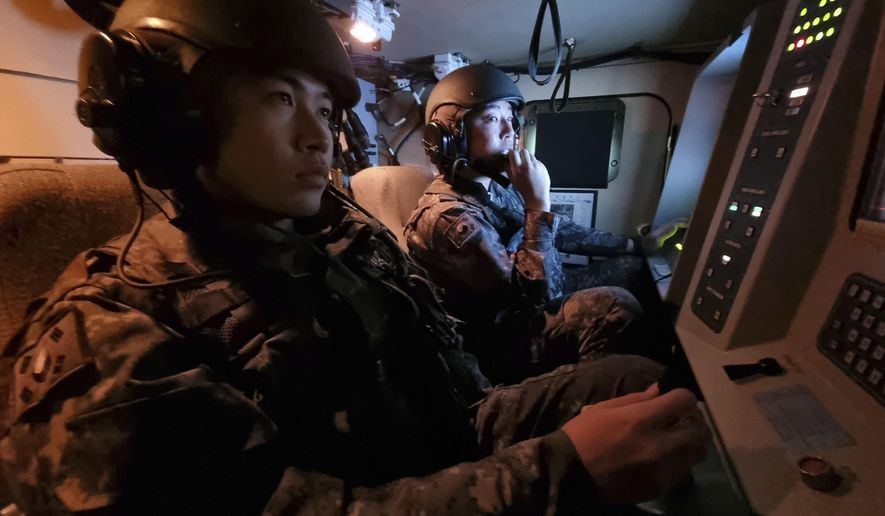SEOUL — South Korean President Yoon Suk Yeol ordered his military to establish a joint command drone unit 10 days after North Korean drones dramatically exposed vulnerabilities of his nation’s skies.
The South’s commitment Wednesday to a response of sending two or three drones north for each drone the North sends south raises questions about Seoul’s compliance with the armistice that halted the 1950-1953 Korean War.
After a briefing from the Agency for Defense Development, the joint chiefs of staff, the National Defense Ministry and the presidential National Security Office, Mr. Yoon ordered Defense Minister Lee Jong-sup to establish a joint drone command to oversee surveillance and reconnaissance operations.
Mr. Yoon also ordered the mass production of small drones and the accelerated development of stealth drones, the Yonhap News Agency reported.
Although South Korean military units already operate drones, the new command will operate “at the strategic and operational level that is different from the existing drone battle level,” the Defense Ministry said in a media release. It will “carry out operations in all areas beyond the army’s command level.”
The conservative Mr. Yoon also suggested that if the North continued drone intrusions, the South should consider revoking a 2018 military agreement with the North to reduce tensions. That deal was signed by his presidential predecessor, the liberal Moon Jae-in.
The presidential office in Seoul said North Korea explicitly violated the agreement 17 times, including 15 times since October, Yonhap reported.
Left unmentioned was the drone command’s potential impact on the 1953 armistice. That deal has maintained an uneasy peace on the peninsula for seven decades. Drone flights over the Demilitarized Zone separating the two Koreas, even in retaliation for incursions, would violate the armistice, analysts said.
Pyongyang’s provocations shocked South Korea, which is customarily blase about its northern neighbor’s hostilities.
On Dec. 26, five North Korean drones penetrated South Korean airspace. Four flew over Paju, the county north of Seoul and south of the DMZ, and one over Ganghwa Island in the Yellow Sea. One flew as far as Seoul’s northern metropolitan area.
Paju is dense with military facilities, including the U.S. military’s 2nd Infantry Division’s base, and Ganghwa Island is strategically located.
South Korean aircraft and helicopters scrambled and fired more than 100 live rounds. A light attack aircraft crashed while taking off, although no casualties were reported.
South Korean drones were dispatched – for the first time, as far as is known – north of the DMZ on a retaliatory surveillance operation.
All the North’s drones disappeared from South Korean radars, but no wreckage was discovered. All five apparently returned successfully to the North. The South Korean military said it was limited because the drones were small, made irregular maneuvers and were not launched from an airfield.
Perhaps most worrisome was the necessity to briefly halt flights at Seoul’s two commercial airports, in Incheon and Gimpo, for more than an hour. That potentially handed Pyongyang a low-cost, low-risk weapon to wage economic war against the South.
The inability of South’s high-tech military to take down the drones created widespread shock.
On Dec. 27, Mr. Yoon ordered the deployment of two or three drones into North Korea for each drone North Korea sends south, though no intrusions have been reported since Dec. 26. On Dec. 29, South Korea conducted drone defense drills involving unmanned aerial vehicles, attack helicopters, light attack aircraft, 20 mm cannon and short-range surface-to-air missiles, or SAMs.
The military response could create a diplomatic headache.
“The context of this discussion is that, with South Korea responding the way it is being implied right now, it is not adhering to the armistice agreement,” Chun In-bum, a retired South Korean lieutenant general, told The Washington Times. “So we find ourselves at the same level as the North Koreans.”
Steve Tharp, a retired U.S. Army lieutenant colonel, said in an interview that a principle of reciprocity exists. Even so, “anytime you fly into the airspace of the other side, that is a violation of the armistice,” Mr. Tharp, who has negotiated extensively with North Koreans, told The Washington Times.
The U.S.-led U.N. Command, which oversees the DMZ, did not respond to a request for comment.
Drones are hardly invulnerable. Ukrainian forces have fought off an onslaught of Russian- and Iranian-made attack drones with electronic jamming, SAMs, radar- and searchlight-guided ground fire, massed small arms and other measures.
Yet Seoul and its environs, densely populated and just 37 miles from the DMZ, presents a particularly tough defensive challenge, and its commercial air volume dwarfs that of Pyongyang. Even debris shot down from an intercepted enemy drone is likely to fall onto sensitive or populated ground.
“Unless we can control the downfall of a drone, it will crash into somebody or something,” said Mr. Chun. “Collateral damage is our problem.”
Small, low-cost drones are ideal asymmetric tools for the impoverished North to deploy against the prosperous South.
“A drone can take out a tank – what an investment that is,” Mr. Tharp said. “What does a drone cost – a couple of thousand dollars? A tank costs a few million.”
• Mike Glenn contributed to this report.
• Andrew Salmon can be reached at asalmon@washingtontimes.com.




Please read our comment policy before commenting.